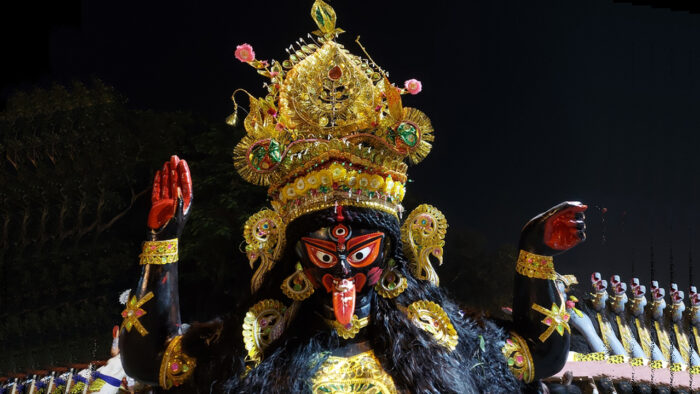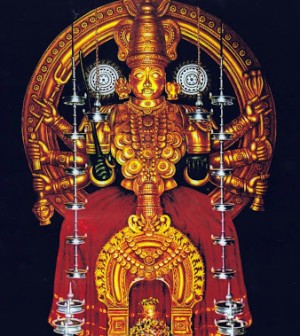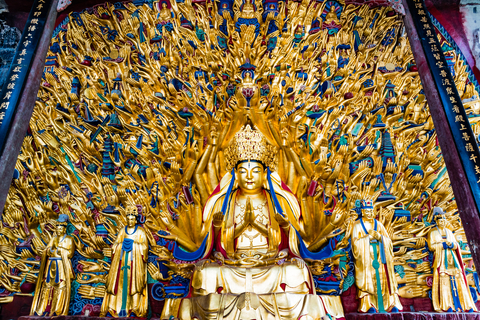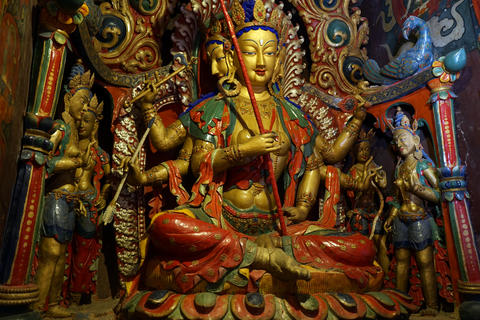Introduction
Tārā is a revered deity in both Hindu and Buddhist traditions. The earliest mention of Tārā in the Hindu tradition can be found in the VirataParva of the Mahabharata, where Yudhistira, the eldest pandava, calls upon the goddess Durga before entering the kingdom of Matsya for their concealed years. In the DurgaStuti, a hymn dedicated to the goddess Durga, Yudhistira invokes the name “Tārini” and prays for her assistance in helping people overcome various challenges, be it navigating treacherous mountains, traversing the depths of the sea, or finding their way in the wilderness[1]. Although the specific mention of Tārā in her present form may not be evident in the invocation of Tārini in the VirataParva, the depiction of the goddess, her powers, and the use of her name in the hymn align closely with Tārā’s later portrayal. This indicates a parallel between the two and suggests a connection between the invocation of Tārini in the VirataParva and the development of Tārā as a distinct deity in later traditions. While the VirataParva of the Mahabharata may not directly depict Tārā in her later form as a Buddhist deity, the invocation of Tārini in the hymn suggests a connection or precursor to Tārā’s later portrayal. This implies that elements of Tārā’s worship and symbolism may have been present in earlier Hindu traditions, which later influenced her development in the Tantric Buddhist context.
Tārā holds the second position among the Dasamahavidyas. The meditative depiction of Tārā, as detailed in her dhyana (“प्रत्यालीढ-पदार्पिताङ्घ्रिशवहृद्…”), portrays her seated in the Virasana posture, with her left foot positioned ahead and the right foot positioned backward on the heart of a deceased body. She grasps Khadga, Kamal, Karttarika (knife), and Kharpar in her hands. This Kharva, arising from the horned seed, symbolizes her power. Her blue, voluminous, and pingal Jatas are adorned with serpents, evoking a sense of inertia in beings from Brahmadev to the world; when propitiated, she obliterates this inertia herself. Such is the meditation upon Tārā Devi. Other than this Satvika, Rajasa and Tamasa meditative forms of Tārā is also worshipped.
Diverse Manifestations of Tārā
BrihadNeela Tantra elaborates on the reverence of Tārā in three distinct forms: UgraTārā, Ekajata, and Nīlasaraswati. Despite the distinct nomenclature, these manifestations ultimately represent the same deity, as stated in the Tārā Tantra: “एकैवहिमहादेवीनाममात्रंत्रिधाभवेत्।”[2]. Within this triad, Nīlasaraswati assumes a significant role, being the consort of UchisshtaGanapathy, a form of Ganesha venerated before embarking on esoteric Tantric practices. The goddess is depicted seated on Ganesha’s lap, in an amorous posture, radiating a distinct blue hue. References affirming Tārā as the consort of UchisshtaGanapathy can be found in UchisshtaGanapathy stotras, for example “श्रीनीलवाणीललितरसिकायनमोनमः” in Ashtothara, “महाचीनोद्भवानारीकुचार्पितकरायनमः” in UchisshtaGanapathySahasranama). Upasakas claim Nīlasaraswati will appear in the end of Yaga as a blue flame which will not burn, but rather having a cooling effect.
The Mūla-Pañcākṣarī of Tārā comprises the sacred syllables Tārākam, Māyā, Vadhū, Kūrca, and the concluding Phatkara. This mantra is structured in the Brhatī meter, and the Rshi associated with this mantra is Akshobhya. The permutation of syllables within the mūla mantra illustrates the manifestation of Tārā in eight distinctive forms:
ताराचोग्रामहोग्राचवज्रानीलासरस्वती
कामेश्वरीभद्रकालीइत्यष्टातारिणीस्मृता।।[3]
Tārā – MāyāVadhūkūrca Phat
Ugrā – VadhūMāyākūrca Phat
Mahogrā – kūrcaMāyāVadhū Phat
Vajrā – kūrcaMāyāVadhū Phat
Nīlā – MāyāVadhū Phat kūrca
Saraswatī – VadhūMāyā Phat kūrca
Kāmeshwarī – MāyākūrcaVadhū Phat
Bhadrakālī – VadhūkūrcaMāyā Phat
(Figure 1: Credit: Wikipedia – Image of Kodungallur Bhagavathy)
It is intriguing to note the similarity between the depiction of Bhadrakāli and Tārā in their iconography. In Kerala’s renowned Saktha temple, Kodungallur, the deity is hailed as Kurumbamma, Kurukullamba, resembling the Red Tārā, also known as Kurukulla. In the Seventeen-syllable of UgraTārā mantra, she is referred to as Padmāvathi. In Nīlasaraswatī mahamantra, she is recognized as Vagvādinī. In the Suryagupta Lineage of Vajrayana, Tārā is described in 21 forms, namely PravitaTārā, ChandraKantiTārā, Kanaka Varna Tārā, UsnisaVijayaTārā, HumSvaraNadiniTārā, TraiLokyaVijayaTārā, VadiPramardaniTārā, MaraSudanaVasitottamaTārā, KhadiravanaTārā, SokaVinodanaTārā, Jagadvasi-Vipan-Nirbarhana-Tārā, KalyanaTārā, PariPacakaTārā, JwalatBhrkutiTārā, Maha Shanti Tārā, RaganisudanaTārā, SukhaSādhanāTārā, SitavijayaTārā, DukhadahanaTārā, SidhiSambhavaTārā, ParipuranaTārā[4]. This compilation of Tārā’s forms is incomplete, as numerous other descriptions are present among practitioners. HiranandaSastri aptly remarks, “The cult of Tārā being so popular that it absorbed other cults of like nature with the result that the divinities of those cults merged into Tārā and their appellation become synonyms of her name.”[5]
The concept of “Kramarahitya” in TārāSādhanā
TārāSādhanā and Mahācīnakramatantra challenges conventional norms and practices within Vedic and tantric worship. The practices followed in these traditions often have specific rules related to the timing of mantras, dietary habits, offerings to deities, and more. Different paths like Daksinācāra, Koula, and Srīvidya each have their own regulations and order of practices. However, TārāSādhanā stands out in that it doesn’t emphasize these rules as crucial. In fact, it exhibits “Kramarāhitya,” a state of being beyond conventional codes, within its practice. This unconstrained approach is elaborated upon in the Mahācīnakramatantra.
In this unfettered form of Sādhanā doubts may arise concerning its validity and whether it aligns with Vedic or non-Vedic principles. This skepticism is addressed in the TārākalpalathaPaddhati authored by Nityananda Narayana Bhatt, where a question is posed as a “purvapaksha” or opposing argument:
ननुमहाचीनक्रमस्यवेदविरुद्धत्वादाचारेनिष्ठानांबोद्धधर्मानुकारित्वेनकथंनब्राह्मणत्वहानिःइति।
“How come there is no Brahmanatvahani for us who are ardent followers of the anti-Vedic traditions of Mahācīnakrama and Buddhadharma?”
The response to this question, termed “siddhanta,” establishes that the Mahācīnakrama encompasses the intricate interplay of dualism and non-dualism, righteousness and unrighteousness, distinctions and indistinctions, gains and losses, truths and untruths, right conduct and misconduct, purity and impurity, emptiness and fullness, touchable and untouchable, edible and inedible, worthy of contemplation and not worthy of contemplation, knowable and unknowable, timely and untimely, wisdom and delusion, among the various spheres of existence. The essence of Mahācīnakrama is intricately woven into its rituals, and this supreme form of worship has its roots in the ancient Vedic tradition, even being practiced by revered sages like Vasiṣṭha and others in the lineage, affirming its Vedic origin.
महाचीनक्रमोनामद्वैताद्वैत-भेदाभेद-धर्माधर्म-विवेकाविवेक-लाभालाभ-न्यायान्याय-सुखासुख-स्वर्गास्वर्ग-शुभाशुभ-कर्तव्याकर्तव्य-शुद्धाशुद्ध-शून्याशून्य-स्पृश्यास्पृश्य- भक्ष्याभक्ष्य-पेयापेय-ध्येयाध्येय -ज्ञेयाज्ञेय- समयासमय-बुधिविनाशकोलोकेषुगोप्यागोप्यतरश्चतुर्वेदोपनिषत्सारभूतस्तत्त्वज्ञानानुरूपोनिरंतरंब्रह्मविद्योपासनोयोगीगुरुपरंपरोपदेशलभ्यःकश्चित्परमोत्कृष्टोधर्मःसोपिवेदमूलएवतस्यवासववसिष्ठादिमहर्षिभिरनुष्ठीयमानत्वात्।।[6]
Mahācīnakramatantra
The Mahācīnakramatantra, like many other Tantras, is presented as a dialogue between Lord Shiva and Goddess Shakti. In the beginning, Goddess Pārvati repeatedly requests to hear the Tantra, and Lord Shiva initially tries to dissuade her from it. At last persuaded by Shakti, Siva dictates the Tantra.
अलंयत्नैरलंयत्नैरलंयत्नैर्महेश्वरि।
चीनाचारक्रमंश्रोतुंविरताभवपार्वती।।
स्त्रीस्वभावेनदेवेशिशश्वन्मांपरिपृच्छसि।
लक्षवारंवारितापिश्रोतुमिच्छतिशङ्करि।।
देव्युवाच
यदिचीनक्रमाचारंनामेकथयसिप्रभो।
प्राणत्यागंकरिष्यामिपुरतस्तेनसंशयः।।
(Mahachinacharakrama Tantra Patala 1)
This exchange signifies the profound secrecy and the potential for misunderstanding associated with this practice.
The Mahācīnakrama Tantra recounts the story of Sage Vasiṣṭha, who dedicated a hundred centuries to intense penance and meditation to invoke the goddess Tārā at the revered Nilachala Mountains (Kamakhya). Despite his fervent efforts, Vasiṣṭha did not achieve success in his TārāSādhanā. Seeking guidance, he approached Brahmadeva, expressing his struggle with the intricate and challenging practice. Motivated by Brahmadeva’s counsel, Vasiṣṭha embarked on a renewed spiritual journey to Kamakhya. Yet, he faced further setbacks and feelings of frustration. In his moment of distress, Vasiṣṭha uttered a curse upon the Tārābija (seed mantra), rendering its spiritual attainment unattainable for others. However, Tārā herself appears before him and guides him, explaining the unique approach of Mahācīnakrama.
रोषेणदारुणमनाःकथंमामशपद्भवान्।मयिआराधनाचारंबुद्धरूपीजनार्द्दनः।
एकएवविजानातिनान्यःकश्चनतत्त्वतः।वृथैवयाम-बहुलःकालोऽयंगमितस्त्वया।
विरुद्धाचारशीलेनममतत्त्वमजानता।तद्बुद्धरूपिणोविष्णोःसन्निधिंयाहिसम्प्रति।
तेनोपदिष्टाचारेणसमाराधयसुव्रत।तदैवसुप्रसन्नाऽस्मित्वयियास्याम्यसंशयः।
(Mahācīnacārakrama Tantra Patala 1)
She conveyed that the profound understanding of the principles and codes of her worship lies with Janardhan, who has taken the form of Buddha. She advised Vasiṣṭha to visit Buddha’s abode and undertake his guidance for his penance. Only by following Buddha’s instructions would Vasiṣṭha be able to attain the level of realization required to connect with Tārā.
In the second patala of the Mahācīnacārakrama Tantra, Vasiṣṭha travels to the region of Cinadesa to seek BhuddarupiJanardhana, who is now in the form of Buddha. As he approaches, he sees Janardhana surrounded by numerous women, indulging in intoxication and revelry. Vasiṣṭha, observing this behavior, becomes perplexed, as it contradicts Vedic norms and customs. He wonders why Lord Buddha, known for his enlightenment, is engaged in such actions.
कामिनीनांसहस्रेणपरिवारीतमीश्वरं।मदिरापानसञ्चातंमदमन्थरलोचनम्।।
दूरादेवविलोक्यैनंवशिष्ठोबुद्धरूपिणम्।विस्मयेनसमाविष्टःस्मरन्संसारतारिणीम्।।
किमिदंक्रियतेकर्मविष्णुनाबुद्धरूपिणा।वेदवादविरुद्धोऽयमाचारःसम्मतोमया।।
(Mahācīnacārakrama Tantra Patala 2)
In response to Vasiṣṭha’s confusion, an Akāshavānī (a divine voice from the sky) resounds, conveying that the unconventional conduct of Lord Buddha is not to be judged by ordinary standards. This conduct represents the highest form of worship and is the supreme code for worshipping Tārinī. The divine voice emphasizes that Tārini’s worship transcends conventional practices and rituals. Hearing this proclamation, Vasiṣṭha bows before Buddha and seeks his guidance. Buddha then proceeds to explain the concept of cīnacāra to Vasiṣṭha.
In Mahācīnacārakrama, the sadhaka (practitioner) conducts all the rituals internally within their mind. This practice transcends the limitations of time, place, dress, bodily purity, and conventional customs. There’s no specific requirement for specific times of day, dress, or even cleanliness. Notably, there’s no need for external purification, and the use of substances like alcohol is permissible, and the sadhaka can eat according to their desire.
स्नानादिमनसःशौचंमानसश्चजपःस्मृतः।पूजनंमानसंदिव्यंमानसंतर्पणादिकं।।
सर्वएवशुभःकालोनाशुभोविद्यतेक्वचित्।नविशेषोदिवारात्रौनसन्ध्यायांमहानिशिवस्त्रासनस्थानगेह-देहस्पर्शादिवारिणः।।
नात्रशुद्ध्याद्यपेक्षास्तिनचमद्यादिदूषणं।सर्वथापूजयेद्देवीमस्नातःकृतभोजनः।
(Mahācīnacārakrama Tantra Patala 2)
The sadhaka follows their own inclination (Swechāniyama) and has the ultimate authority over their worship. This approach liberates the practitioner from rigid guidelines and allows them to create their own spiritual path.
नजपेकालनियमोनचदिक्षुबलिष्वपि
स्वेच्छाचाराक्तादिरतःप्रचरेद्हृष्टमानसः।
(MahācīnacārakramaTantra Patala 2)
In 4th patala Vasiṣṭha’s query about the effects of alcohol, meat consumption, and indulgence in sensual pleasures raises questions that are still relevant today.
मद्यपानेनमनुजोसिद्धिंसम्पत्लभेत्प्रभो।मद्यपानरताःसर्वेसिद्धिंयान्तुव्यपाश्रयाः।।
मांसभोजनमात्रेणयदिपुण्यागतिर्भवेत्।लोकेमांसाशिनःसर्वेपुण्यभाजाभवन्तिवै।।
स्त्रियोभोगेकौलिकानांयदिमोक्षोभवेदिह।सर्व्वेपिजन्तवोलोकेमुक्ताःस्युःस्त्रीनिवेषणात्।।
(Mahācīnacārakrama Tantra Patala 4)
Vasiṣṭha questions whether mere consumption of meat and alcohol could truly lead to virtue, as that would imply that all meat-eaters and alcoholics would inherently become virtuous. Similarly, he questions the possibility of attaining liberation (Mukthi) through indulging in sensual pleasures with women. The same question is asked by Pārvati to Siva in Kulārṇava Tantra (Kulārṇava Tantra Ullasa2, verse 117-120)
The responses given by both Siva in the Kulārṇava Tantra and Buddha in the Cinācāra Tantra are quiet similar.
वृथापानंयत्क्रियतेसुरापानंतदुच्यते।
समहापातकीचैववेदादिषुनिरूपितः।।
(Mahācīnacārakrama Tantra patala 4)
वृथापानन्तुदेवेशिसुरापानंतदुच्यते।
तन्महापातकंज्ञेयंवेदादिषुनिरूपितम्।।
(Kulārṇava Tantra Ullasa 2, verse 123)
Buddha, in his response, clarifies that these practices are valid, and success can be attained through them. However, the tantric path, as exemplified by mahācīnacārakrama, doesn’t conform to conventional norms. Instead, it emphasizes the individual’s state of mind, signifying the supreme Adhikari (qualified practitioner) for this approach.
शुद्धिंनकारयेद्देवनिर्विकल्पमनाश्चयः।
नात्रशुद्ध्यादपेक्षास्तिनचमद्यादिदूषणम्।।
(Mahācīnacārakrama Tantra patala 2)
“निर्गताःविकल्पाःयस्मात्तत्निर्विकल्पं।निर्विकल्पंमनःयस्यसःनिर्विकल्पमनाः।
The term “Nirvikalpamanah” refers to an individual whose mind is free from distractions and conflicting thoughts. This state of mind aligns with the essence of Mahācīnacārakrama Tantra, signifying the practitioner’s qualification to engage in this unconventional form of worship.
Overall, Mahācīnacārakrama tantra introduces the concept of “manasa puja” (mental worship) taken to an advanced level. It goes beyond conventional classifications, rules, and practices, providing ultimate freedom to the practitioner. The essence of the practice lies in the practitioner’s state of mind and their connection with Tārā, rendering other aspects insignificant in comparison. The emphasis shifts from external rituals to internal contemplation, where the practitioner’s mental state and focus hold paramount importance. The unconventional nature of this practice challenges established conventions, providing practitioners with a unique path to spiritual growth and connection with Tārā’s divine energies.
Tārā in Buddhism
(Figure 2: Credit: Dreamstime – Avalokitesvara with Thousand Hands)
Within the context of Buddhism, a distinct narrative presents itself regarding the worship of Tārā. This narrative revolves around Avalokitesvara, a significant figure known for embodying compassion. As Avalokitesvara approaches the threshold of attaining nirvana, the ultimate state of liberation from the cycle of rebirth, a collective sorrow resonates across all living beings in the world. This shared lamentation deeply moves Avalokitesvara, prompting him to shed a tear driven by his profound compassion for the pervasive suffering endured by sentient beings. This compassionate tear transforms into Tārā, who then emerges as the very embodiment of boundless compassion itself. Consequently, Tārā is venerated as the epitome of supreme compassion and stands as a distinctive symbol of benevolence within Buddhist traditions.
(Figure 3: Credit: Dreamstime – Depiction of Tārā in Buddhist Traditions)
Conclusion
In the journey of spiritual exploration, the concept of Tārā emerges as a powerful and versatile archetype, transcending the confines of religious and cultural boundaries. The profound significance of Tārā finds resonance in the Upanishadic quote ‘तरतिशोकमात्मविद्’, which defines the enlightened as those who transcend the ocean of sorrows. Tārā’s very name, meaning तारयतिइतितारा “one who helps cross,” reflects her pivotal role in guiding beings across the sea of Samsara. This essence resonates whether considering Tārā as the second Mahavidya, Nīlasaraswati, or in her myriad forms revered in Buddhism. This theme of liberation echoes the ultimate reality that underpins diverse traditions. As TārāSādhanā dissolves the shackles of religious frameworks and customs, it emerges as a timeless philosophy that earnest seekers can embrace without reservation. The code of TārāSādhanā, rooted in the mind’s alignment with the eternal essence, offers a profound path towards inner transformation and realization.
Bibliography
- Brihannilatantra
- Mantrakosha_5706_1246, Shri Raghunatha Temple MSS Library, Jammu – folio 29
- TārāKalpalataPaddati- Nityananda Narayan Bhat_4881_ Alm_22_shlf_2
- MahachinacharaKrama Tantra_5536_Alm_25_Shlf_3_1069, Shri Raghunatha Temple, MSS Library Jammu
- Zasep Rinpoche, Tārā in the palm of your Hand
- Taratantram
- Kularnavatantra
- Uchishtaganapthikalpa
- Discussion with Sri RambhauSwamikal, i.e.; Fire yogi of Tanjore.
[1]DurgaSthuthi by Yudhishtra – Hindupedia, the Hindu Encyclopedia,” n.d.; Ganguli, 1896; Vyasa, 1955
[2]Taratantram, Patala 5
[3]Mantrakosha_5706_1246, Shri Raghunatha Temple MSS Library, Jammu – folio 29
[4]Zasep Rinpoche, Tārā in the palm of your Hand.
[5]HiranandaSastri, Origin and cult of Tārā, P.2
[6]TārāKalpalataPaddati- Nityananda Narayan Bhat_4881_ Alm_22_shlf_2
Feature Image Credit: dreamstime.com
Conference on Tantra & Tantric Traditions
Watch video presentation of the above paper here:
Disclaimer: The opinions expressed in this article belong to the author. Indic Today is neither responsible nor liable for the accuracy, completeness, suitability, or validity of any information in the article.











